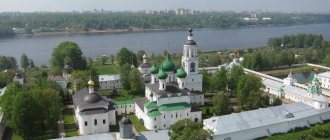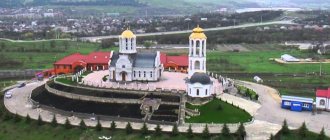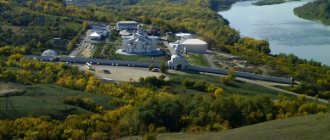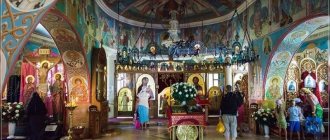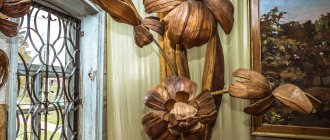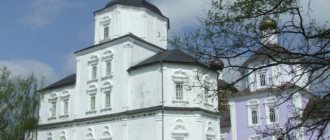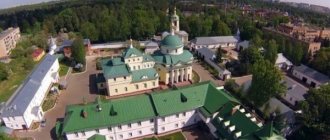Holy monasteries are always built in places that have a deep history and are especially important to people. Likewise, the St. Barsanuphievsky Convent, despite its young age (it is only about 20 years old), has a long history, dating back to the 18th century.
Today the monastery rises high on a hill near the village of Pokrovskiye Selishchi, which is located in Mordovia. The monastery was founded in 1996. This place is considered holy due to numerous legends and holy omens. Every Orthodox Christian should visit the monastery to plunge into the holiness and silence of these places.
Description and location
The Holy Barsanofevsky Monastery appeared in Pokrovskiye Selishchi, Zubovo-Polyansky district of the Republic of Mordovia, in the place where there used to be a parish.
Distance from major Russian cities: Moscow is 450 kilometers away, Saransk is 186 kilometers away, and the regional center is 15 kilometers away.
The place where the monastery stands is high. In the very center is a temple consecrated in honor of Saint Barsanuphius. If you look for this place on the map, its coordinates are: N54°0'12.72″ and E43°0'9.79″.
If suddenly you didn’t know yet, we recommend reading the article with a description and history of the creation of St. Basil’s Cathedral.
Monastic life
St. Barsanuphius Convent (Mordovia) has lived according to monastic laws since its foundation. The organizer of the monastery, Abbot Alexy, and the abbess, Abbess Barsanuphia, make every effort to develop the monastery. There are already more than a hundred sisters living in the monastery under the cenobitic charter. Significant issues of monastic and monastic life are resolved by the Spiritual Council.
The St. Barsanuphievsky Convent adopted a strict rule of monasticism as a rule. Here, every day during the day, a large circle of services is performed, the Psalter is constantly read, and prayers are performed to the saints according to the days of the week. Daily memorial services have become a tradition, prayers are held in honor of the Mother of God.
The sisters strive to take zealous participation in all church rituals and prayers. In addition to the general church service, there are monastic morning and evening rules. One of the important daily events is the nightly procession of the cross around the monastery with the icon of the feast of the day or St. Barsanuphius.
Founding of the monastery
In the Saransk diocese, this monastery is considered the youngest. After all, it appeared only twenty years ago, in 1996.
The history that we mentioned at the very beginning is indeed more ancient, its roots go back to the reign of Elizabeth Petrovna, when, in fact, the conversion of the local people to Christianity took place. The Mokshans showed themselves to be zealous Christians. In 1756, they undertook to build not one temple, but two, both wooden. No sooner said than done. This is how the Intercession (cold) and St. Nicholas (warm) churches appeared. And the village received its name from one of them - Pokrovskie Selishchi.
There were already well over 5.5 thousand believers in the Pokrovsko-Selishchensky parish by the 19th century. Over time, he found himself divided in two. One remained in Pokrovskiye Selishchi, where St. Nicholas Church is. And the Intercession Church with its almost four thousand local residents formed a second one - in neighboring New Vyselki (Bozunovka).
This is interesting: even before the beginning of the last century, the village residents collected enough funds to erect, instead of the old cold building, a grandiose stone temple in honor of the Feast of the Intercession of the Blessed Virgin Mary.
On the eve of the canonization of a venerable old man named Seraphim (1903), the Bozunovsky and Selishchensky men happened to be included in the number of train guards whom the royal persons followed from the railway station to Sarov. And from that very time on, the icons of that saint began to be especially revered here.
Reviews
A large flow of pilgrims annually goes to the St. Barsanuphius Convent. Reviews about the monastery are the most flattering, filled with words of gratitude and some surprise. It often comes as a surprise to visitors that such a large monastery has a very short history. But, having gotten to know the sisters better, their way of life and the general mood prevailing in the monastery, everyone will understand why he blossomed so much in a short time. There is an atmosphere of goodwill, active active good-heartedness, obedience, love for neighbors and for any work.
Many were surprised by the rule of placing pupils with their sisters in the same cell, which pursues family education for children who have lost their parental love at an early age. This fact cannot be denied, but is an unusual form of guardianship. Looking at the children, it becomes clear that there is a lot of benefit from such a tradition, but no harm at all.
Pilgrims were pleased to see the well-groomed territory, large lands and participate in the prayer life of the monastery in accordance with the local charter. Many people provide all possible assistance to the sisters through deeds, financial participation, or simply prayer.
The number of pilgrims is constantly growing, and this is largely the merit of Abbot Alexy (St. Barsanuphius Convent). Father Alexey, whose reviews are flattering, as one of the most authoritative clergy of the Saransk diocese, is doing everything possible for the monastery. It was through his tireless labors that the women’s monastery in Pokrovskiye Selishchi arose and flourishes. His active position and unshakable faith not only support monastic life, but also changed the village way of life, for which local residents are grateful to the abbot.
Fate during the revolution and in Soviet times
Both churches managed to survive until the revolutionary events without problems. And then it was difficult to defend the temples. Years of persecution began.
Please note: it was then, according to local elders, that the prophetic words of the maiden Daria, the former blessed one, were heard. It happened to her to “see with spiritual eyes.” She was told from above that “a candle will light up from earth to heaven” exactly where the Church of the Intercession of the Mother of God stood. It is from this prediction that they count down the beginning of the monastery.
Blessed Daria is no longer in this world. Only people remembered her words. In difficult times they warmed people's hearts.
Temples were closed. The one made of stone, in Novye Vyselki, was destroyed right down to the very foundation. So it stood in a state of disrepair. In Pokrovsky, the Bolsheviks opened a club, and warehouses were located here. By the 1970s, this temple was also demolished.
The 75th year of the last century was significant. The temples were declared monuments and were now protected by the state. Only seventeen years later did they return to the jurisdiction of the Saransk diocese, from the very formation of which residents from Pokrovsky Villages petitioned for this. The parish was given the name of St. Barsanuphius.
Even in the St. Nicholas Church, destroyed and robbed, repair work continued, there was no roof, and services were already taking place. Only thanks to the efforts of parishioners and believers and numerous donations, the temple was transformed. Already at the beginning of 1992, Hieromonk Alexy celebrated the first Divine Liturgy there. And the sisterhood appeared through his own efforts.
By 1996, the number of sisters exceeded twenty. And instead of the parish, a convent appeared, called St. Barsanuphius.
Story
The St. Barsanuphievsky Convent was founded on the territory of the parish of the village of Pokrovskie Selishchi in 1743 by decree of Empress Elizabeth. Initially, two churches were built there - Pokrovsky and Nikolsky. Since then, the local population strengthened in the Orthodox faith and grew in numbers, so that the parish was soon divided into two new ones.
St. Barsanuphievsky Convent in Mordovia
In 1903, local peasants took part in guarding the royal train to Sarov on the eve of the canonization of St. Seraphim. With the beginning of the revolution, believers were able to defend their churches, but in 1934 the buildings were taken away for Bolshevik purposes. The church in Novye Vyselki was destroyed to the foundation.
Other buildings were robbed and stood empty; later they were used as warehouses. Despite the fact that historians recognized the buildings as historical monuments in 1975, the Church of the Intercession was completely destroyed.
The restoration of the parish began in 1991, and after the emergence of the Saransk diocese, restoration and restoration of buildings began. The re-consecration of St. Nicholas Church took place in 1992, when it was renamed in honor of St. Barsanuphius. In 1996, by decree of the Patriarch of Rus', the local community began to officially be called a monastery.
Since then, several new cell buildings and a hotel for pilgrims have been built, the main temple has been restored and several brownies have been organized. Currently, 45-60 nuns permanently live on the territory.
Restoration and modernity
But he did not limit himself only to the role of a place of prayer. The task was much broader - to turn it into a real center of spiritual, educational and social service.
And at the same time, the monastery continues to be built and lives with its worries:
- Farmland is cultivated with all care and skill. Grain, fodder and vegetable crops are cultivated here, and medicinal herbs are grown. There is a garden and its own bees.
- The barnyard is filled with cattle, sheep and goats. There is a poultry house where they breed chickens and geese, even turkeys and ducks. And the monastery ponds are full of fish.
It is also necessary to say about other obediences. Here they bake prosphora, care for infirm old women, raise and educate monastery children, study the history of the church in the Mordovian region and at the same time do not leave other things to do:
- produce dairy products;
- salt the fish;
- prepare canned vegetables;
- various fruits and herbs are dried;
- prepare healing balms and tinctures, ointments from medicinal herbs.
And this is not a complete list of things that occupy the days of the monastery sisters.
Nuns work in other jobs:
- They publish spiritual literature in their own bookbinding workshop;
- They sew their own monastic church and everyday clothes and priestly vestments. For these purposes we have our own sewing workshop;
- The ancient traditions of monastic needlework are preserved and developed here. They are engaged in icon painting and weaving belts, embroidery and knitting.
It's worth noting: there is no staff limit here. Today, 60 sisters live and work: nuns, nuns and novices. Moreover, not all of them are from these places. There are people who arrived here from Russian regions. All their days are spent in service, prayer and obedience.
Righteous Works
The life of the sisters is filled to the brim with labors and prayers. To provide for their own needs, gardens and vegetable gardens are laid out on the monastery lands, wheat, rye and other agricultural crops are grown. The barnyard is filled with animals, there are cows, goats, and sheep. The monastery breeds chickens, ducks, turkeys, and geese. Fish splash in the ponds.
The apothecary garden of the monastery is one of the places where it is pleasant to visit and learn new things about the surrounding plants and understand their medicinal properties. The traditions of folk medicine are supported by the St. Barsanuphius Convent. The ointments made by the sisters are very popular and cure many diseases. The drug is based on natural raw materials - beeswax, medicinal herbs and God's blessing.
In 2004, the monastery won the main prize of the thematic exhibition “Christmas Gift” for medicinal preparations and a blend of herbs. Medicines, herbal and medicinal teas can be purchased at exhibitions, directly at the monastery, or you can make a request to the monastery in any convenient way.
The sisters have a lot to worry about, and everything needs to be done. Here they care for the sick, teach and care for children, the sisters themselves read a lot of spiritual literature, and continue their own education. Much time is devoted to local history research. Abbess Barsanuphia rules the way of life with a firm hand, and the St. Barsanuphius Convent flourishes through her labors and prayers. Mother Jeremiah acts as the monastery’s accountant, she is energetic, full of strength and energy, ready to do more than her job requires.
The nuns zealously observe the rules of the monastery, which require humility, renunciation of their own will and many prayers and services. The troubles of a varied household also fall on their shoulders. At the monastery there are workshops for sewing vestments for priests, an icon painting workshop, a book binding workshop, the art of embroidery is being improved, and warm clothes are knitted.
Temples of the monastery
The monastery of St. Barsanuphius is rich in temples and churches.
Cathedral of the Resurrection of Christ
There are eight of them:
- The snow-white “pearl” is the Cathedral of the Resurrection of Christ. He is the most important. It was founded in 2002, quite recently;
- Nearby is a single-domed church called Varsanofievskaya; in honor of the saint, with a bell tower, the former Nikolskaya - the same one that was built back in the 1740s. Pokrovskaya was also raised from the ruins. The house church of St. Nicholas was consecrated in 1999. It is located in a building rebuilt from an old library;
- In December 2010, the consecration of the house church of the healer and great martyr Panteleimon at the almshouse took place, and in May 2012 - the single-domed gate church of the Archangel Michael, which was built back in 2005. It will still continue to be decorated and furnished;
- In New Vyselki, one and a half kilometers from the monastery, a wooden courtyard church named in honor of the monastery will soon be completed. Vladimir, Metropolitan of Kyiv;
- In Pokassy there is another such architectural monument of the 19th century - the wooden Church of the Nativity;
- Well, the eighth. He rose two kilometers away from the Holy Spring itself.
Worldly concerns
The main concern of monastics is prayer, but in any monastery they devote a lot of time to worldly affairs. Monastic life can be considered an attempt to create an ideal community where mutual understanding, prayer, love for any neighbor and incessant work for the common welfare reign. During its short history, the St. Barsanuphievsky Convent demonstrates adherence to the fundamental principles of Orthodoxy, where the social sphere is as important as the prayer rule.
The monastery operates an orphanage for girls, for whom life at the monastery means normal socialization, education and, above all, love. Many of them have seen a lot of grief in their short lives, traumatized by parental abandonment and cruelty. There are several students with disabilities. The girls live at the monastery and receive a full school education. To reveal their talents, the sisters teach them all types of needlework, drawing, and singing. Pupils are full participants in monastic life.
Due attention is also paid to elderly members of the community. An almshouse has been set up for them, where elderly nuns and pious laywomen who have no relatives live. They receive medical care and care. For spiritual needs, there is a temple of Panteleimon the Healer in the building; bedridden patients receive communion in their cells. The medical center at the monastery provides professional assistance not only to its nuns, but also to local residents. Reception is conducted by nurses with medical education.
Resurrection Cathedral
Ten-domed white stone, shaped like a cross - it was founded at the very beginning of the century.
Take into account: in its 390-meter bell tower there are eight bells of different sizes. If you weigh them, the total weight will be two hundred pounds. Of these, the largest one, the hundred-pound one, was cast in 2004.
The lower church is consecrated in honor of the icon of Our Lady of the Sign, and the upper one is dedicated to the Resurrection of Christ.
The entire cathedral covers an area of 680 square meters. m. It was not easy to choose a place for it. For this purpose, a stone house with wooden buildings and the land of the director of the local school, who was an ardent enemy of the faith of Christ, were purchased. Bishop Barsanuphius proposed another place for the temple - a cemetery, which is on the monastery territory. And there were several such proposals.
Interesting fact: Hieromonk Alexy had to pray fervently for a sign from the Lord. Which is what he did until the yard burned down completely, and with it the wooden bathhouse. As it turned out, the material for its construction was logs left over from the old temple. This fire was considered a long-awaited sign - with fire the Lord illuminated the place where the cathedral should rise. And Father Alexey, like a perspicacious old man, was able to foresee and see this sign.
But this was not the only sign. The first floor had already been erected when, during the Nativity Fast, the Cross Not Made by Hands suddenly appeared on the ceiling. It was huge, made of frost, perfectly shaped, and literally shone. Until the very beginning of Lent, it remained unchanged. This really served to strengthen my faith.
The cathedral is still being developed: decoration and painting are being done, the iconostasis is being installed and other work is underway.
Origin of the name and its meaning
The monastery borrows its name from the same temple, at the behest of Bishop Barsanuphius of Saransk and Mordovia (now Metropolitan of St. Petersburg and Ladoga), who named the most ancient temple on the monastic land, glorifying his namesake saint.
On October 17, according to the new style, the Orthodox Church honors the memory of Barsanuphius, known as the Bishop of Tver, Kazan, a saint and endowed by the Lord with miracles. The patronal feast of the bright monastery is commemorated on the same date.
The discovery of the miraculous relics of the illustrious Barsanuphius, the most holy Bishop of Tver (year of repose 1576), as well as the holy hierarch Gurias, in the rank of righteous Archbishop of Kazan (year of repose 1563), took place in Kazan in 1595.
During the construction of a new white stone church to glorify the Transfiguration of the Lord on the territory of the Transfiguration Monastery, the founder of which was Saint Barsanuphius himself, the coffins of the saints of God with their fragrant relics were brought to light near the dilapidated wall of the altar of the old church. Their discovery was accompanied by amazing phenomena.
Saint Gury was full of healing and fragrant peace. The funeral clothes were also unharmed.
Only the saint’s lips were slightly touched by decay. He also opened another tomb, that of the righteous Barsanuphius.
By the reverence of God, the miraculous, almost completely preserved relics of the elder were revealed to the light and his clothes were also unharmed.
There is also evidence of many healings that occurred then, anointed with the most holy myrrh, flowing from the shrine of St. Gurias.
The good and joyful service on this day is complemented by the veneration of the namesake of the mother abbess of the parish, who was tonsured and named Barsanuphia.
For more than 20 years now, she has humbly carried her arduous cross for the glory and prosperity of the holy place.
Holy spring
A source emanating healing water is located three kilometers from the monastery.
He became famous for his waters, pure and healing.
It simply could not be otherwise.
In this wondrous place, real soldiers of Christ worked, fasted and prayed.
This is interesting: they say that in a dream a blind girl was ordered to go to a spring and wash herself with its water. And as soon as she did this, a miracle happened - she received her sight, and the Don Icon of the Mother of God appeared before her. People decided that it was God who blessed this region, endowing the air and water with healing powers. So they gave the source the name of the icon of the Mother of God of the Don.
An old chapel once stood on this site, destroyed after the revolution. But in order to preserve the memory of that miracle for centuries, they built a new one in 2000, and seven years later they built an indoor bathhouse.
The number of pilgrims is growing every year. There is no doubt about the healing power of the Holy Spring. They plunge into its waters and ask for intercession in sorrows and illnesses.
Interesting facts and legends
The centuries-old history of the Intercession-Selishchensky places contains not only the written facts of the formation of monastic lands and lands, but also various allegories and eyewitness accounts of the Lord's signs.
- There is a legend that during the consecration of a strong, majestic temple in honor of the honorable Protection of our Lady, a certain maiden named Daria predicted its inevitable and imminent complete collapse. Subsequently, her words turned out to be prophetic. She also said that in these places “a candle will light up from the very earth to the heavens.” With these words she foreshadowed the appearance of a holy, god-pleasing monastery.
- An interesting fact about signs in the wonderful Cathedral of the Resurrection of Christ. The sisters and clergy talk about the glorious appearance of the site for the future construction of this cathedral. They say that the Lord himself cleared the land with fire for a new snow-white shrine on a plot of land that had been purchased by that time into the monastery’s ownership. According to legend, a fire occurred on it, which destroyed all the wooden buildings, since they were made of wood material from the old church.
- Another event that defies scientific explanation occurred there in 2003. From the beginning of the forty-day Nativity Fast, when the lower portion of the cathedral was being erected, the outline of a huge, clear cross made of sparkling frost inexplicably appeared on its vaults. It continued until the time of Lent. It is believed that this miracle was sent by the Savior to further strengthen the right faith in God's Providence.
Social services of the monastery
With Christianity, charity came to Rus'.
It was destined to become a very important tradition of compassion, pity, sympathy, love for one's neighbor. And the St. Barsanuphievsky Monastery is an excellent confirmation of this. Since 2002, an almshouse has been operating on its territory.
Lonely old women and about 20 nuns live here. Divine services are held every week in the house church built at the monastery. Everyone who cannot get up and move independently is given communion directly in their cells.
Please note: those sisters who have a medical education, higher or secondary, receive patients at the monastery. And not only residents of the monastery can count on medical assistance, but also any pilgrim or local resident.
The shelter for orphans provides education for twenty-five little girls aged 3-18 who are left without parents. Some of them simply found themselves in a difficult situation, some are disabled. Each has its own home - a cell and its own “mother”, its own bed and corner with toys. And the care for patients is such that even cerebral palsy recedes.
The children of the nuns also live on the territory of the monastery. That’s why they opened a kindergarten here. It differs little from other children's institutions: the same teachers, nannies, it has its own music worker, and a nurse comes. Their mothers are at their obediences during the day and in the evenings after work they pick up the girls from kindergarten.
Please note: there is even a dental office in the kindergarten, and schoolgirls drop in to see their little ones here to babysit them.
There is also a school at the monastery. They teach the Russian language, literature, mathematics, and here they learn about history, including Orthodoxy.
The monastery’s project “Museum for Friends” became a participant in the “Orthodox Initiative 2015-16” competition and turned out to be the best. And as a result, a significant event happened here - the opening of a church history museum with quite a variety of exhibitions. They are dedicated to the history of the village and the monastery itself, the culture and traditions of the people inhabiting it (Mordovian-Moksha).
Activities of the parish
The parish has been led by Archimandrite Alexy (Degaev) since February 1992. He went from abbot of the monastery to confessor and abbot. Today he directs all the activities of the parish, conducts services and meetings with pilgrims and parishioners.
The nuns take special care of the younger generation, which is why a shelter is opened here for orphans or those who find themselves in difficult life situations. Today, 5 disabled children live and are raised here permanently, as well as from 3 to 18 girls in need of housing and assistance.
Those living in the shelter often live in cells with nuns, so that they can help them grow as spiritually healthy people by positive example. There is a kindergarten on site for children whose mothers live in the monastery as nuns.
There is also an almshouse at the monastery - about 20 nuns and elderly women who need care and concern live there. All residents regularly attend divine services, and those who are bedridden participate in the Sacrament of the Eucharist with the help of nuns.
Divine services in the monastery are conducted by Abbot Alexy
Sisters with medical training at the almshouse have opened an outpatient reception center and receive pilgrims, local residents and nuns, trying to alleviate illnesses and provide first aid. The monastery is entirely self-sufficient through agriculture. Here the nuns do:
- growing vegetables and fruits, as well as wheat crops and feed;
- livestock breeding (production of dairy products);
- maintaining a poultry house (chickens, ducks, turkeys);
- beekeeping;
- herbalism (pharmaceutical herbs are grown in the local garden, ointments and balms are made, and medicinal mixtures are prepared);
- fishing (carp are grown in a local pond).
On the farmstead there is a printing, bookbinding and sewing workshop, a bakery (bread and prosphora are baked), a smokehouse and a curing room (fish, vegetables and fruits are stored for the winter). In 2021, a church history museum was opened at the parish, dedicated to the history of the village, the culture of Mordovia and the traditions of the local people. The nuns necessarily participate in the work, taking on responsibilities in one of the areas of the parish’s activities.
Shrines and patronal feasts
In the monastery, the main relic is considered to be the holy spring in honor of the Mother of God “Donskaya”, whose waters are considered miraculous and healing. A small chapel of the same name was built near the source (in 2000) and an indoor bathhouse, which is used to bless the water on Epiphany and other holidays.
Mosaic icon of St. Barsanuphius on the gate church of the monastery
The novices of the monastery especially venerate St. Barsanuphius, Bishop of Tver, whose memorial days are celebrated on April 11 and October 4, as well as Hieromartyr Vladimir, Metropolitan of Galicia and Kyiv, whose memorial days fall on January 25 and June 14. Holidays are also celebrated after which local churches were named:
- St. John the Evangelist (May 21);
- St. John the Baptist (October 6);
- icons of the Mother of God “The Sign” (December 10);
- St. Nicholas (December 19);
- Intercession of the Virgin Mary (October 14);
- vlmchn. Panteleimon (August 9);
- Archangel Michael (November 21);
- Icon of the Mother of God “Life-Giving Spring” (Friday of Bright Week).
In the monastery, the two most revered images are St. Nicholas the Wonderworker and St. Seraphim of Sarov.
Miracles
All the miraculous events that happened here are connected with the holy spring, which is located on the territory of the monastery, but at some distance from the main buildings. It all started long before the founding of the monastery here - when there was only a wooden church here, a local village girl who suffered from blindness prayed and asked the Mother of God to heal her.
Temple in honor of the Icon of the Mother of God “Life-Giving Spring”
The Mother of God heard the pure and sincere prayers of the child and at night appeared to her in a dream, pointing to the source. The child went to the indicated place and washed himself there with clean water. The girl was healed immediately and saw the icon of the Mother of God of the Don that appeared to her.
Interesting! Since then, the spring has been considered miraculous; many people who prayed at it and drank its water received healing from illnesses and were freed from demons and sins.
The second obvious miracle occurred during the construction of the cathedral in the monastery. For a long time the architect could not choose the right and good place for the building. He began to pray and ask God for wisdom; in response to the prayer, a terrible fire occurred on the territory - the building of a local atheist enemy, which he had built from the remains of old church boards, burned down.
Here they decided to build a new cathedral. During construction, in late autumn, a large cross made of frost suddenly appeared on the ceiling of the unfinished building, which remained there until Lent.
Information for pilgrims and tourists
Postal address: s. Pokrovskie Selishchi, Zubovo-Polyansky district, Republic of Mordovia, Russia.
You can call: (834-58) 3-84-23, 3-84-20 and 3-84-66.
Take note: the official website of the monastery is located at: https://varsonofy.ru/. Here you can always find up-to-date information about the life of the monastery, about the events taking place in it, and find out any questions of interest.
The reception of pilgrims at the monastery never stops. Individually and in groups, from different Russian cities, they will all receive a warm welcome and be provided with food and accommodation. The novices give tours of the monastery.
Museum
A museum of church-historical significance has been created and is successfully operating on the basis of the monastery. It is not only the brainchild of the sister community, but also of many residents of the Zubovo-Polyansky district - workers in the educational and cultural spheres, child care institutions and students throughout the region.
The main exhibitions cover the following topics:
- life of Mordovian society;
- culture;
- history of the region;
- formation of the monastery;
- saints and revered by the Orthodox people, ascetics who lived or labored in this region.
Rules for visiting the nunnery
Of course, anyone who finds himself on the territory of the monastery must adhere to certain rules so that his stay does not disrupt the rhythm of life and activities of the monastic community and does not contradict the norms of life of this godly place.
Here you can't:
- wear shorts, sportswear, open dresses;
- drink, smoke and be in a state of intoxication, alcohol or drugs;
- go onto lawns and pick flowers;
- take photographs and videos without appropriate permission;
- for a woman to be bareheaded and in indecent clothing;
- a man wearing a headdress should be in the temple;
- talk while the service is going on;
- turn on mobile phones.
Help to the central regional hospital
The nuns of the prayer house in the name of the Mother of God and the image of her “Tsaritsa” encourage everyone to take an active and very valuable participation in a good project and provide all possible assistance to the central regional hospital.
His Grace Clement, the venerable Bishop of Krasnoslobodsky and Temnikovsky, blessed the organization of the sisterhood in the territory called Zubova Polyana at the temple in the name of the Lady, and the bright image of her all-sung “All-Tsaritsa”. Anyone can join the project as sisters of mercy.
Schedule of services
Divine services in the monastery are held traditionally for the Russian Orthodox Church according to the instructions of the Typikon. Movable and immovable liturgical circles are taken into account.
| Name of main services | Frequency of liturgical readings |
| Divine Liturgy. | Every day, except for days on which other readings are provided for by the Charter. |
| Serial prayer services with blessing of water. | After the Liturgy, on all days when it is celebrated. |
| Prayer service to Archangel Michael. | On Mondays. |
| Prayer service to the Forerunner and Baptist of Christ John. | On Tuesdays. |
| Prayer service to the Mother of God for the sake of her image “Life-Giving Source”. | On Wednesdays. It takes place in the temple at the holy spring. |
| Prayer readings to St. Nicholas. | On Thursdays. |
| Prayer services to all saints. | On Saturdays. |
| Prayer readings with ordered akathists. | On Sundays and holidays. |
| Panikhida (service of remembrance of the dead). | On the days of the Liturgy, after the celebration. prayer service with blessing of water. |
Since its foundation, the community of sisters of the St. Barsanuphievsky Monastery has been active in charitable activities, implementing projects that help people. Holy icons attract pilgrims and parishioners.
Author: Volokhova Ekaterina
Article design: Mila Friedan
Address. How to get to the monastery
- You should take a commuter train to Zubova Polyana station (Kazan direction), then take a taxi to the monastery itself.
- From the bus station, along the route to Spassk, and to the Novye Vyselki station, from the station on foot 2 km.



